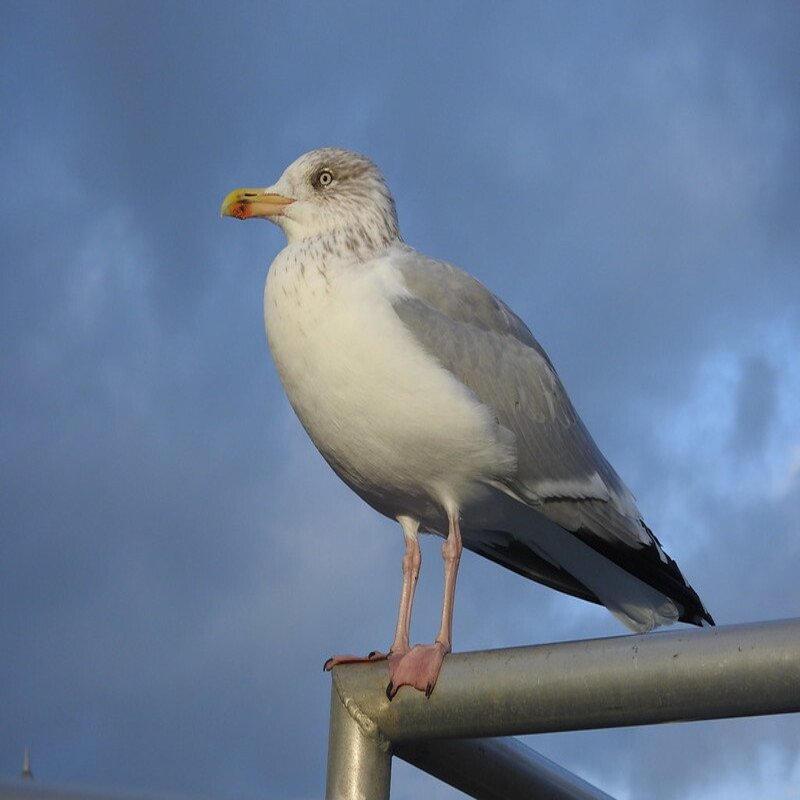The European herring gull, Larus argentatus is a big gull that can reach a length of 66 centimeters (26 in). It was previously one of the most common gulls along the coastlines of Western Europe. It breeds in Northern, Western, Central, and Eastern Europe, as well as Scandinavia and the Baltic republics. While some European herring gulls, particularly those found in colder regions, move south in the winter, the majority remain year-round inhabitants.
Quick Overview: Larus Argentatus – Herring Gull
Body size: Around 22-26 in (56-66 cm) and a weight of 1499 g (52.9 oz)
Main colors: Gray, White, Black, Yellow, Pink
Range: Throughout the United States
Migratory Bird: Yes
Best time of the year to see in the U.S.: January, February, December
Conservation Status: Least Concern
Herring Gull Description
This huge gull has a pale gray back, black-tipped wings, a white head, neck, breast, tail, and underparts, and a white head, neck, breast, tail, and underparts. Yellow bill with a red patch near the tip; pink legs.

Size
These birds have a length of 22-26 in (56-66 cm) and a weight of 1499 g (52.9 oz). Their wings could range from 54-58 in (137-147 cm).
Feeding
The Herring Gull is a scavenger and generalist predator. Fish, mollusks, crustaceans, insects, earthworms, mammals, and berries are natural meals, as are eggs, young, and adults of other seabird species, including conspecifics; and carrion, which includes dead fish, aquatic birds, and mammals.
Habitat
Numerous habitats, most of which are related to water. The most numerous species are found along the shore and surrounding large lakes, as well as along significant river systems. Forages in the sea, on beaches, mudflats, plowed fields, and marshes, as well as any other location where human activity supplies food (garbage dumps, picnic grounds, docks, fishing operations).
Behavior
Herring gulls are a colonial species that nest in colonies. They do, however, take great care to safeguard their designated zone within a colony. Among herring gulls, social hierarchies vary; adults are often dominant over adolescent gulls, and while females dominate in terms of nest site selection, males may dominate females in terms of feeding and boundary conflicts. Herring gull pairs nest at the same location for as long as the male is alive and has not abandoned the female.
Larus Argentatus Scientific Classification
- Kingdom: Animalia
- Phylum: Chordata
- Subphylum: Chelicerata
- Class: Aves
- Order: Charadriiformes
- Family: Laridae
- Genus: Larus
- Species: Larus argentatus
Best time of the year to see
The best time to see these birds in the United States is during the winter season (December to February).
Distribution of the Herring Gull in the USA
Breeds from Alaska to the Maritime Provinces in northern Canada, south to British Columbia, north-central Canada, and the Great Lakes, and along the Atlantic coast to North Carolina. Winters in all except the most northern breeding grounds of the species, ranging from southern Alaska to Baja California.
The Herring Gull can be found in the following states in the United States – Alabama, Arizona, Arkansas, Colorado, Connecticut, Delaware, Florida, Georgia, Hawaii, Idaho, Illinois, Indiana, Iowa, Kansas, Kentucky, Louisiana, Maine, Maryland, Massachusetts, Michigan, Minnesota, Mississippi, Missouri, Montana, Nebraska, Nevada, New Hampshire, New Jersey, New Mexico, New York, North Dakota, Ohio, Oklahoma, Oregon, Pennsylvania, Rhode Island, South Carolina, South Dakota, Tennessee, Texas, Utah, Vermont, Virginia, Washington, West Virginia, Wisconsin, and Wyoming.
